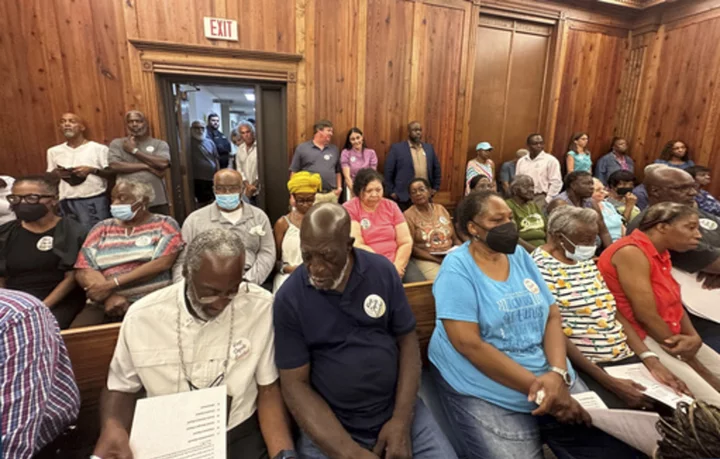DARIEN, Ga. (AP) — Descendants of enslaved people living on a Georgia island vowed to keep fighting Tuesday after county commissioners voted to double the maximum size of homes allowed in their tiny enclave, which residents fear will accelerate the decline of one of the South's few surviving Gullah-Geechee communities.
Black residents of the Hogg Hummock community on Sapelo Island and their supporters packed a meeting of McIntosh County's elected commissioners to oppose zoning changes that residents say favor wealthy buyers and will lead to tax increases that could pressure them to sell their land.
Regardless, commissioners voted 3-2 to weaken zoning restrictions the county adopted nearly three decades ago with the stated intent to help Hogg Hummock's 30 to 50 residents hold on to their land.
Yolanda Grovner, 54, of Atlanta said she has long planned to retire on land her father, an island native, owns in Hogg Hummock. She left the county courthouse Tuesday night wondering if that will ever happen.
“It’s going to be very, very difficult,” Grovner said. She added: “I think this is their way of pushing residents off the island.”
Hogg Hummock is one of just a few surviving communities in the South of people known as Gullah, or Geechee, in Georgia, whose ancestors worked island slave plantations.
Fights with the local government are nothing new to residents and landowners. Dozens successfully appealed staggering property tax hikes in 2012, and residents spent years fighting the county in federal court for basic services such as firefighting equipment and trash collection before county officials settled last year.
“We're still fighting all the time,” said Maurice Bailey, a Hogg Hummock native whose mother, Cornelia Bailey, was a celebrated storyteller and one of Sapelo Island's most prominent voices before her death in 2017. “They're not going to stop. The people moving in don't respect us as people. They love our food, they love our culture. But they don't love us.”
Hogg Hummock’s population has been shrinking in recent decades, and some families have sold their land to outsiders who built vacation homes. New construction has caused tension over how large those homes can be.
Commissioners on Tuesday raised the maximum size of a home in Hogg Hummock to 3,000 square feet (278 square meters) of total enclosed space. The previous limit was 1,400 square feet (130 square meters) of heated and air-conditioned space.
Commissioner Davis Poole, who supported loosening the size restriction, said it would allow "a modest home enabling a whole family to stay under one roof.”
“The commissioners are not out to destroy the Gullah-Geechee culture or erase the history of Sapelo," Poole said. “We’re not out to make more money for the county.”
Commission Chairman David Stevens, who said he's been visiting Sapelo Island since the 1980s, blamed Hogg Hummock's changing landscape on native owners who sold their land.
“I don’t need anybody to lecture me on the culture of Sapelo Island,” Stevens said, adding: "If you don’t want these outsiders, if you don’t want these new homes being built ... don’t sell your land.”
County officials have argued that size restrictions based on heated and cooled spaced proved impossible to enforce. County attorney Adam Poppell said more than a dozen homes in Hogg Hummock appeared to violate the limits, and in some cases homeowners refused to open their doors to inspectors.
Hogg Hummock landowner Richard Banks equated that to the county letting lawbreakers make the rules.
“If everybody wants to exceed the speed limit, should we increase the speed limits for all the speeders?” Banks said.
Hogg Hummock residents said they were blindsided when the county unveiled its proposed zoning changes on Aug. 16. Commissioners in July had approved sweeping zoning changes throughout McIntosh County, but had left Hogg Hummock alone.
Commissioner Roger Lotson, the only Black member of the county commission, voted against the changes and warned his colleagues that he fears they will end up back in court for rushing them.
Two attorneys from the Southern Poverty Law Center sat in the front row. Attorney Anjana Joshi said they had “due process and equal protection concerns” about the way the zoning ordinance was amended.
“In our view, this was not done correctly,” said Joshi, who added: “We're just getting started.”
Located about 60 miles (95 kilometers) south of Savannah, Sapelo Island remains separated from the mainland and reachable only by boat. Since 1976, the state of Georgia has owned most of its 30 square miles (78 square kilometers) of largely unspoiled wilderness. Hogg Hummock, also known as Hog Hammock, sits on less than a square mile.
Gullah-Geechee communities are scattered along the Southeast coast from North Carolina to Florida, where they have endured since their enslaved ancestors were freed by the Civil War. Scholars say these people long separated from the mainland retained much of their African heritage, from their unique dialect to skills and crafts such as cast-net fishing and weaving baskets.
Hogg Hummock earned a place in 1996 on the National Register of Historic Places, the official list of the United States' treasured historic sites. But for protections to preserve the community, residents depend on the local government in McIntosh County, where 65% of the 11,100 residents are white.









